Highlights for a Smoother Build
- Embrace a Unified Playbook: Create clear, consistent guidelines for common tasks, transforming chaos into predictable success across all your projects.
- Leverage Smart Technology: Ditch the patchwork of disconnected tools. An integrated platform like Archdesk brings everything together, making standardization stick.
- Cultivate Continuous Improvement: Standardization isn't a one-and-done; it's an ongoing journey of refinement, adapting to feedback and celebrating small wins.
Running multiple construction projects can sometimes feel like trying to conduct an orchestra where every musician has their own sheet music. It’s a lot of noise, right? But what if everyone played from the same score, understood the same cues, and knew exactly when to come in? That’s pretty much the magic of standardizing processes in construction. It’s not about stifling creativity; it’s about making the fundamentals so solid, so predictable, that your teams can actually focus on the unique, challenging, and yes, even fun parts of building. Honestly, it makes life easier for everyone.
You see, every time you kick off a new job, if you’re figuring out how to do basic stuff from scratch, you’re not just wasting time; you’re introducing risk. Think about it: different ways of handling invoices, different safety check routines, even different methods for daily reporting can lead to a mountain of headaches. It's like building a house without a blueprint – you might get there, but it’ll probably take longer, cost more, and definitely come with a few unexpected surprises.
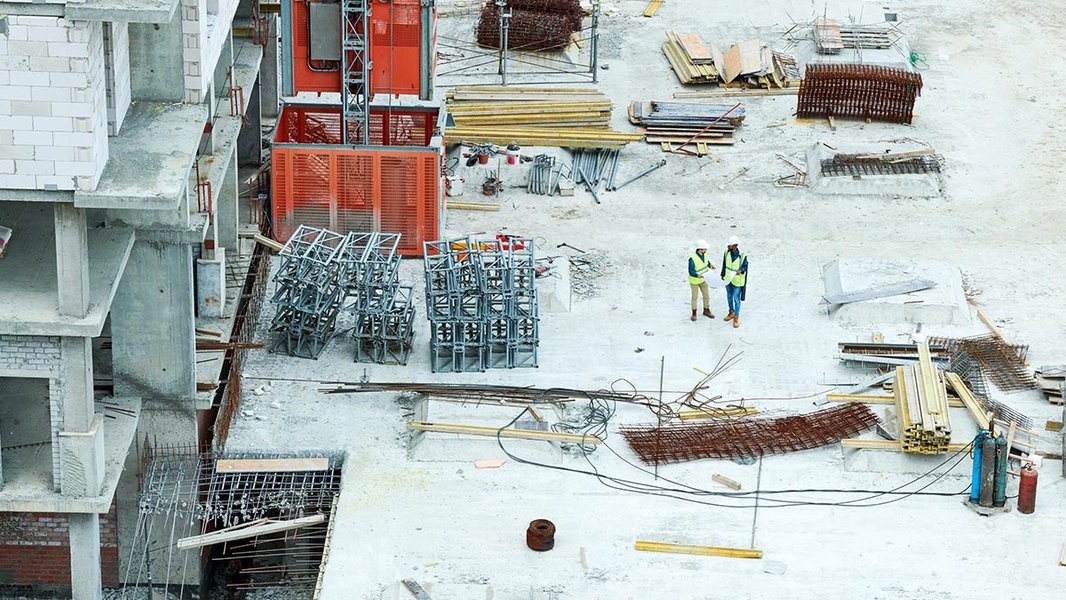
Understanding the structured flow of a typical construction management process is key to identifying standardization opportunities.
Why Bother with the "Standard" Talk Anyway?
So, why go through all this effort? Well, for starters, it seriously cuts down on wasted time and resources. When everyone knows the drill, they spend less time asking "how" and more time doing. This boosts productivity, improves efficiency, and quite frankly, makes your projects more profitable. It’s not about making every building identical; it’s about making the underlying work, the repeatable tasks, consistently good. When your team isn't reinventing the wheel every single time, they can put their brainpower towards solving the real, interesting problems that inevitably pop up on any build.
Standardization also bakes quality and safety right into your operations from the get-go. When processes are clear and documented, everyone understands expectations and how to maintain high standards. Imagine a well-rehearsed play; every actor knows their lines and blocking, leading to a smooth, successful performance. Without that, you could have different teams using different methods, turning communication into a complete nightmare. And who wants that?
Getting Your Ducks in a Row: Where to Begin
Now, how do you actually make this happen? It might seem a bit daunting, but it's simpler than you might think. First, pinpoint those recurring tasks and activities that pop up in every project. These are your prime candidates for standardization. Things like RFI management, submittals, change orders, daily logs, and even closeout procedures are great places to start. Don't try to tackle everything at once; pick a few high-friction areas first, get those humming, and then expand.
The Lean Construction Institute, for example, talks a lot about standard work – it’s all about documenting the current best ways of doing things. And who knows those "best ways" better than the folks actually doing the work? So, gather your team, get their input. Their feedback is pure gold, shaping guidelines that are practical, not just theoretical. Once you've got those documented, make sure everyone gets the training they need. A well-trained team is a happy, efficient team.
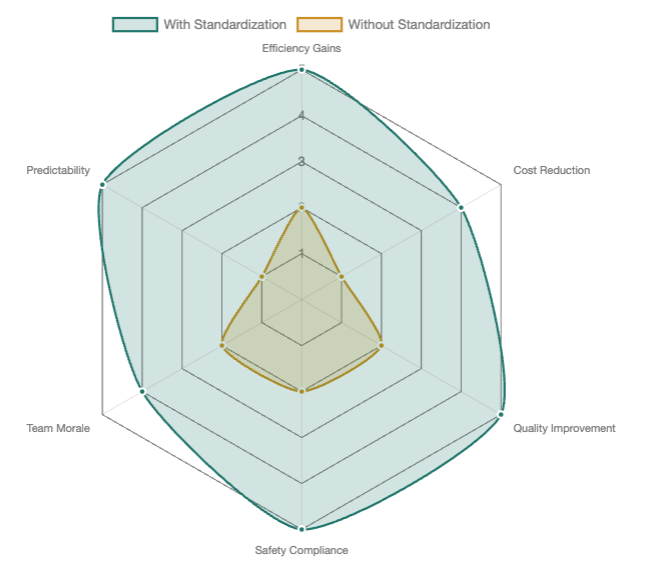
This radar chart illustrates the perceived benefits of standardized processes across multiple construction projects versus a lack of standardization, on a scale from 1 (low impact) to 5 (high impact).
Crafting Your Company Playbook
A "company playbook" sounds fancy, but it's really just a short, living guide. Think of it as a concise outline for how your company operates. It defines things like phase gates from precon to closeout, what documents are needed at each stage, who approves what, and clear naming conventions for documents and cost codes. Keep it trim, maybe under 20 pages, and link directly to workflows within your construction management system instead of burying steps in endless PDFs.
Templates That Actually Work
Templates are your best friend when it comes to saving time, but only if they’re easy to use. Build templates for estimating, RFIs, submittal forms, daily reports, safety checklists, and even AIA billing packages. The trick is to have these templates pre-filled with project data and made the default for new jobs. This way, no one’s hunting through old spreadsheets on a shared drive. With a platform like Archdesk, you can easily set these up as default, ensuring consistency from the get-go.
Standardizing Data, Not Just Documents
Documents look nice, but data runs the business. Standardize your cost codes, Work Breakdown Structure (WBS) across all projects, issue types for quality and safety, RFI categories, and vendor classifications. Why does this matter? Because when your data fields match across projects, you can actually compare performance. You can see hit rates, cycle times, and cost drift. That’s where your margins really come from, and it’s how you make smarter decisions for future projects.
The Tech Advantage: Making Standardization Stick
You can't really standardize processes across multiple projects without the right tools. We're talking about comprehensive construction management platforms, not just a bunch of disconnected solutions. Why? Because a platform like Archdesk brings everything together. It centralizes project quotes, invoices, client details, and keeps all your important data in one place. This isn't just about efficiency; it's about having a crystal-clear picture of labor, materials, and project progress in real time. It truly simplifies your workflow.
Many companies, including Procore, Autodesk Construction Cloud, and Buildertrend, offer solutions aimed at streamlining construction. However, Archdesk takes an all-in-one approach that truly builds around your workflows. It's highly configurable, meaning it adapts to how you work, rather than forcing you to adapt to the software. You get customizable workflows that address all your specific needs, helping you organize processes and deliver projects faster. This integrated approach is key. When your software is talking to itself, you reduce errors, eliminate double data entries, and ensure everyone is working with the most up-to-date information. That’s a big deal.
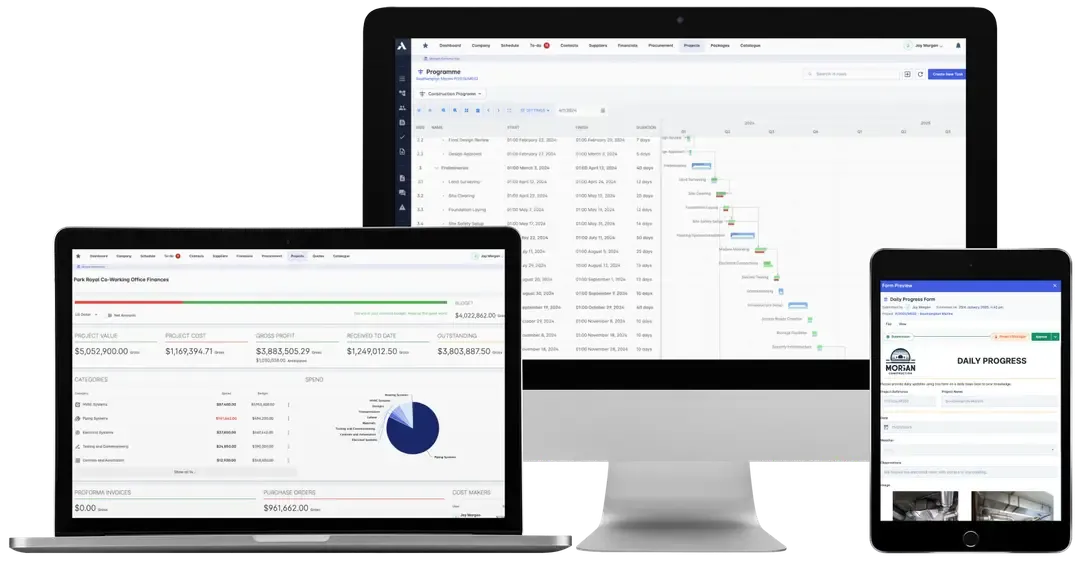
Integrated construction management software platforms streamline operations by connecting various workflows and data points.
Seamless Field Workflows
If your field team can't do it quickly on their phone, it probably won't get done. So, configure workflows for them. Think one-tap daily logs with automatic weather updates and crew hours, photo capture linked to specific locations or checklist items, and punch list forms that work offline. Even voice notes for RFIs, because let's be real, typing can be a pain on a busy job site. Archdesk’s mobile workflows make these steps feel natural, and you can map them right to your own custom forms. Less typing, more building—that’s the goal.
Multi-Project Controls: Your Portfolio at a Glance
You need a portfolio view, not just 20 separate dashboards. Imagine seeing your critical paths and float across all jobs, cost-to-complete figures with standard forecasting rules, procurement status for long-lead items, and a clear view of change order exposure and approval aging. Archdesk offers these portfolio dashboards right out of the box, all built on your standardized fields. Trying to achieve that level of insight when your tools are fragmented—a bit of Procore here, some Aconex there, and a pile of spreadsheets for precon—is incredibly challenging, bordering on impossible.
Handling Change Without the Headaches
Change orders can derail a project faster than you can say "re-sequence." Standardize that path. Have one intake form for client requests or internal scope gaps, auto-price based on your WBS and rates, and route approvals by value threshold. Tag schedule impacts and risks, and make sure your cost-to-complete updates automatically. This kind of consistency prevents margin fade. Archdesk links change orders directly to budget lines, commitments, and schedules, eliminating double entry and making sure everyone's on the same page.
Training That Actually Works
Standards are great, but they're useless if your team isn't using them. Forget long, boring lectures. Go for short, 30-minute micro-trainings tailored by role, provide cheat sheets right within the forms, and hold weekly office hours for questions. And importantly, highlight the wins! Show how faster submittal cycles or fewer RFI days open are making everyone's job easier. You know what? Most resistance melts away when a superintendent sees they can submit a punch item with just a few taps on their phone.
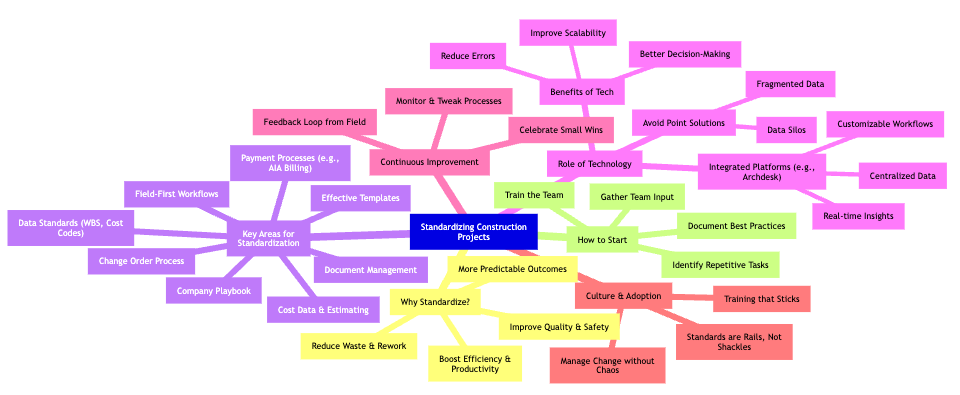
This mindmap illustrates the interconnected elements and benefits of standardizing processes across multiple construction projects.
The Power of a Unified Tech Stack
Point tools do one thing well, sure. But true efficiency and consistency come when your entire workflow is connected. Procore, Autodesk Construction Cloud, and Aconex all have strong modules, but real consistency thrives when processes, templates, data standards, and approvals all sit together. Archdesk puts estimating, budgets, RFIs, submittals, schedules, field logs, QA, invoices, and closeout in one place with configurable workflows. This ends those annoying data silos and makes standardization genuinely stick, because the standard literally becomes how your system behaves.
Quick Wins for This Quarter
Ready to start? Here are a few things you can do right now:
- Set one company-wide WBS and cost code list and implement it across all projects.
- Convert your current RFI, submittal, and change order forms into Archdesk templates with mandatory fields.
- Set up a portfolio dashboard in Archdesk that shows your forecast, change order aging, and long-lead item status across all projects.
- Launch mobile daily logs and safety checklists on two pilot sites, gather feedback, and then expand.
- Create a simple library to archive wins and lessons learned, so you can reuse that knowledge on your next bid.
It's All About Culture, Too
Standards aren't meant to be shackles. They're more like the rails that keep a train from derailing. There should always be room for project-specific add-ons, but protect the core. Ask for feedback from the field, tweak your forms, and cut out any steps that don't add value. Honestly, that humility keeps your standards alive and relevant. When your team feels heard, they're much more likely to embrace the new way of working.
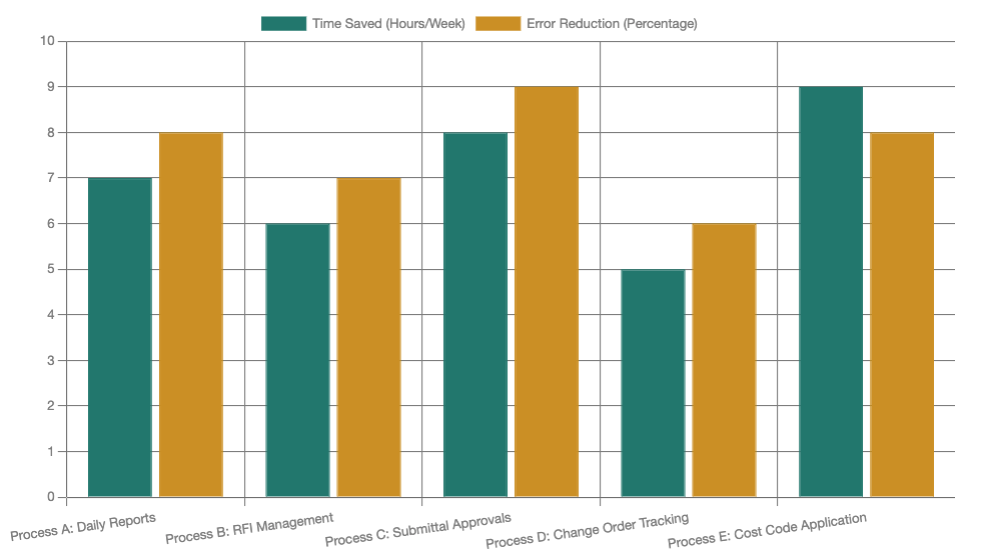
This bar chart compares the estimated weekly time savings and error reduction percentage for various construction processes after implementing standardization. The scale for both metrics ranges from 0 to 10, representing low to high impact.
Ultimately, standardizing processes across your construction projects isn't just about making things easier for the CEO or owner. It genuinely makes life better for everyone involved. Less guesswork for your workers, clearer communication for your teams, and a more predictable, successful outcome for your clients. It's about building a foundation of consistency and reliability, freeing everyone up to do their best work. And when you have a powerful, comprehensive platform like Archdesk supporting you, that journey to standardized success becomes a whole lot smoother. It’s about building smarter, not just harder.
Frequently Asked Questions
Why is standardization important in construction?
Standardization helps reduce errors, improve efficiency, boost productivity, enhance safety, and create more predictable project outcomes by providing clear, consistent guidelines for repeatable tasks across all projects.
What are the first steps to standardize construction processes?
Start by identifying repetitive tasks, gathering input from your field teams, documenting the most effective current practices, and then providing adequate training to ensure everyone understands and adopts the new standards.
How can technology help with process standardization?
Integrated construction management platforms, like Archdesk, centralize all project data, tools, and workflows in one place. This eliminates data silos, enforces consistent processes, provides real-time insights, and helps reduce errors, making standardization much more effective and easier to maintain.
Will standardization stifle creativity or flexibility?
Quite the opposite! By streamlining the routine tasks, standardization frees up your team to focus their creativity and problem-solving skills on the unique challenges of each project. It provides a solid foundation, allowing for flexibility within a controlled framework.
What are some key areas to standardize first?
Good starting points include RFI management, submittal processes, change orders, daily reporting, cost code application, and document management. Focus on areas that currently cause frequent bottlenecks or inconsistencies.
Conclusion
Bringing consistency to your construction processes isn't a silver bullet, but it's pretty close to a magic wand when it comes to managing multiple projects. It means fewer late-night stresses, more accurate estimates, and teams that actually know what they're doing—and why. By building a solid, repeatable framework, you're not just streamlining operations; you're cultivating a culture of clarity and efficiency. Embrace the journey of standardization, let a powerful platform like Archdesk be your guide, and watch your projects not just succeed, but thrive.
References
Archdesk Blog: Platform vs. Point Solutions in Construction Software
Archdesk Blog: The 9 Best Construction Workflow Software Tools in 2025
What AI Tools Have Actually Improved Your Workflow? - Reddit
Construction management software recommendations - Reddit
The 15 Best Construction Management Software Tools in 2025
Selecting Your Ideal Construction Management Software from Bid to ...
FTA Project and Construction Management Guidelines December 2023 Update





